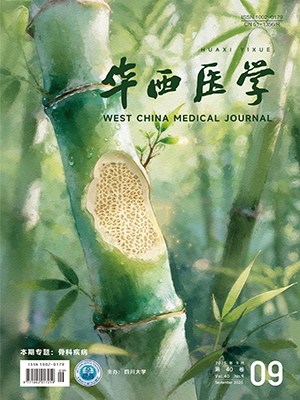| 1. |
Wu S, Wu B, Liu M, et al. Stroke in China: advances and challenges in epidemiology, prevention, and management. Lancet Neurol, 2019, 18(4): 394-405.
|
| 2. |
Tsai CF, Thomas B, Sudlow CL, et al. epidemiology of stroke and its subtypes in Chinese vs white populations. Neurology, 2013, 81(3): 264-272.
|
| 3. |
王旭. 沈陽地區腦卒中發病與氣象環境因素的相關性. 中國臨床康復, 2006, 10(36): 12-13.
|
| 4. |
汪宏莉, 韓延柏, 梯正之. 日本廣島市腦卒中發病與氣象條件關系. 中國公共衛生, 2009, 25(5): 606-607.
|
| 5. |
方萬里, 馬利娟. 寧波地區腦卒中發病規律與氣象誘因統計分析. 中國衛生統計, 2014, 31(1): 137-138.
|
| 6. |
王克英, 崔甍甍, 張進軍. 氣象因素對腦血管疾病急性發病影響的病例交叉研究. 中國全科醫學, 2015, 18(22): 2662-2666.
|
| 7. |
Huang K, Liang F, Yang X, et al. Long term exposure to ambient fine particulate matter and incidence of stroke: prospective cohort study from the China-PAR project. BMJ, 2019, 367: l6720.
|
| 8. |
董繼元, 陳永聰, 張本忠, 等. 蘭州市氣溫對腦卒中發病的滯后效應研究. 氣候變化研究進展, 2017, 13(4): 366-374.
|
| 9. |
程學偉, 韓兆洲. 市域腦卒中疾病與氣象因素的關系及預測. 氣象, 2018, 44(6): 837-843.
|
| 10. |
中華醫學會神經病學分會, 中華醫學會神經病學分會腦血管病學組. 中國急性缺血性腦卒中診治指南 2018. 中華神經科雜志, 2018, 51(9): 666-682.
|
| 11. |
Shin DW, Yoon JE, Hwang HW, et al. Numbers of stroke patients and stroke subtypes according to highest and lowest daily temperatures in Seoul. J Clin Neurol, 2016, 12(4): 476-481.
|
| 12. |
王臨池, 葛錫泳, 陸艷. 大氣中 NO2 和 SO2 對蘇州市居民腦卒中. 中國預防醫學雜志, 2019, 20(9): 817-821.
|
| 13. |
周玉慶, 袁洪, 黃志軍, 等. 長沙市大氣污染物與腦卒中急診關系的病例交叉研究. 環境與健康雜志, 2014, 31(9): 764-768.
|
| 14. |
郝宇, 費占洋, 張軒, 等. 北京地區腦梗死發病與干支運氣及氣象因子的關聯性研究. 北京中醫藥大學學報, 2014, 37(8): 556-558.
|
| 15. |
Butland BK, Atkinson RW, Crichton S, et al. Air pollution and the incidence of ischaemic and haemorrhagic stroke in the South London Stroke Register: a case-cross-over analysis. J Epidemiol Community Health, 2017, 71(7): 707-712.
|
| 16. |
Wing JJ, Adar SD, Sánchez BN, et al. Ethnic differences in ambient air pollution and risk of acute ischemic stroke. Environ Res, 2015, 143(Pt A): 62-67.
|
| 17. |
Kim J, Yoon K, Choi JC, et al. The association between wind-related variables and stroke symptom onset: a case-crossover study on Jeju Island. Environ Res, 2016, 150: 97-105.
|
| 18. |
黃德生, 關鵬, 周寶森. Logistic 回歸模型擬合 SARS 發病及流行特征. 中國公共衛生, 2003, 19(6): T1-T2.
|
| 19. |
Alaka SA, Menon BK, Brobbey A, et al. Functional outcome prediction in ischemic stroke: a comparison of machine learning algorithms and regression models. Front Neurol, 2020, 11: 889.
|
| 20. |
Ottenbacher KJ, Smith PM, Illig SB, et al. Comparison of logistic regression and neural networks to predict rehospitalization in patients with stroke. J Clin Epidemiol, 2001, 54(11): 1159-1165.
|
| 21. |
丁少華, 陳宇辰, 殷信道, 等. 構建急性腦卒中機械取栓治療后預后預測模型的研究. 磁共振成像, 2021, 12(8): 11-14, 21.
|
| 22. |
張麗娜, 李國春, 周學平, 等. 基于支持向量機的急性出血性腦卒中早期預后模型的建立與評價. 南京醫科大學學報(自然科學版), 2016, 36(1): 80-84.
|
| 23. |
王海東, 張璐, 王潔, 等. C5. 0 決策樹與 RBF 神經網絡模型用于急性缺血性腦卒中出血性轉化的風險預測性能比較. 中華疾病控制雜志, 2019, 23(2): 228-233.
|
| 24. |
Zhu M, Chen WH, Hiedes JP, et al. The K-nearest neighbor algorithm predicted rehabilitation potential better than current Clinical Assessment Protocol. J Clin Epidemiol, 2007(60): 1015-1021.
|




